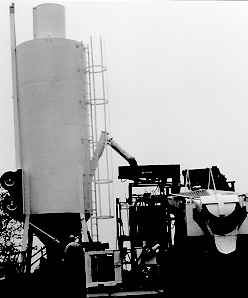
(MAECTITE® Chemical Treatment Process)
The patented MAECTITE® chemical treatment process for lead and other heavy metals uses reagents and processing equipment to render soils, waste, and other materials nonhazardous when tested by the Resource Conservation and Recovery Act toxicity characteristic leaching procedure (TCLP). The MAECTITE® process reduces leachable lead, hexavalent chromium, and other heavy metals to below treatment standards required by land-ban regulations (September 19, 1994 40 CFR Parts 268, Final Rule). Lead in treated material, as determined by approved EPA methods in SW-846 (such as the TCLP, extraction procedure toxicity test, and the multiple extraction procedure), complies with limits established by EPA. The photograph below shows a 500-ton-per-day unit.

500-Ton-Per-Day MAECTITE® Processing System
Chemical treatment by the MAECTITE® process converts leachable lead into insoluble minerals and mixed mineral forms within the material or waste matrix. MAECTITE® reagents stimulate the nucleation of crystals by chemical bonding to yield mineral compounds in molecular forms. These forms are resistant to leaching and physical degradation from environmental forces. The durability of traditional monolithic solidification-stabilization process end-products is often measured by geotechnical tests such as wet-dry, freeze-thaw, permeability, and unconfined compressive strength. The MAECTITE® process does not use physical binders, is not pozzolanic or siliceous, and does not rely on the formation of metallic hydroxides using hydration mechanisms. Therefore, these tests are not relevant to MAECTITE® product chemical stability, although engineered properties are readily obtained, if required. MAECTITE® is not pH dependent and does not use adsorption, absorption, entrapment, lattice containment, encapsulation, or other physical binding principles. The technology is a true chemical reaction process that alters the structure and properties of the waste, yielding stable compounds.
The MAECTITE® process uses water to assist in dispersing reagents. However, the dehydration characteristic of the process liberates water present in waste prior to treatment (absorbed and hydrated forms) to a free state where it can be removed from the waste matrix by evaporation and capillary drying principles. The ability of treated material to readily lose water, the formation of dense mineral crystals, and the restructuring of the material as a result of MAECTITE® treatment (where interstitial space is minimized), all contribute to reduced waste volume and weight.
Ex situ MAECTITE® processing equipment generally consists of material screening and sizing components, liquid and solid reagent storage delivery subsystems, and a mixing unit such as a pug mill. Equipment is mobile but can be modified for fixed system operations. In situ MAECTITE® processing equipment is also available; system selection is largely dictated by contaminant plume configuration, soil characteristics, and site space limitations.
Materials that have been rendered nonhazardous include soils; sludges; sediments; battery contents, including casings; and foundry sands. Oversized material can be treated with the process as debris, but size reduction often makes processing more efficient. Even sludges with free liquids (as determined by the paint filter test) have been treated to TCLP compliance when excess fluids are present.
The range of lead levels effectively treated has not been fully determined; however, soils with total lead as high as 30 percent (by weight) and TCLP values over 15,000 milligrams per liter (mg/L) were not problematic. Common lead levels encountered have averaged from 200 milligrams per kilogram (mg/kg) to 6,500 mg/kg with TCLP averaging 20 to 400 mg/L. Material geochemistry most often dictates final MAECTITE® treatment designs. Furthermore, correlations between total lead and regulated leachable lead levels are inconsistent, with treatment efforts more strongly related to the geochemical characteristics of the waste material.
The chemical treatment technology was initially accepted into the SITE Demonstration Program in March 1992. EPA is seeking a suitable demonstration site.
Sevenson Environmental Services, Inc. (Sevenson), acquired the MAECTITE® technology in 1993 and was issued second and third patents in 1995 and 1996, respectively. Combining ex situ and in situ quantities, over 400,000 tons of material has been successfully processed. Treatability studies have been conducted on over 100 different materials in over 40 states, Canada, Italy, and Mexico. The technology has been applied at full-scale demonstration and remedial projects in over 20 states and in all 10 EPA regions.
The MAECTITE® process has been formally accepted into the EPA PQOPS program for the fixation-stabilization of inorganic species. Proprietary technology modifications have shown promise in rendering radionuclides nonleachable using gamma spectral counting methods on TCLP extract. Sevenson is treating 30,000 cubic yards of radioactive-contaminated material using their proprietary technology modifications.
EPA PROJECT MANAGER:
Jack Hubbard
U.S. EPA
National Risk Management Research Laboratory
26 West Martin Luther King Drive
Cincinnati, OH 45268
513-569-7507
Fax: 513-569-7620
TECHNOLOGY DEVELOPER CONTACT:
Karl Yost
Sevenson Environmental Services, Inc.
9425 Calumet Avenue, Suite 101
Munster, IN 46321
219-836-0116
Fax: 219-836-2838